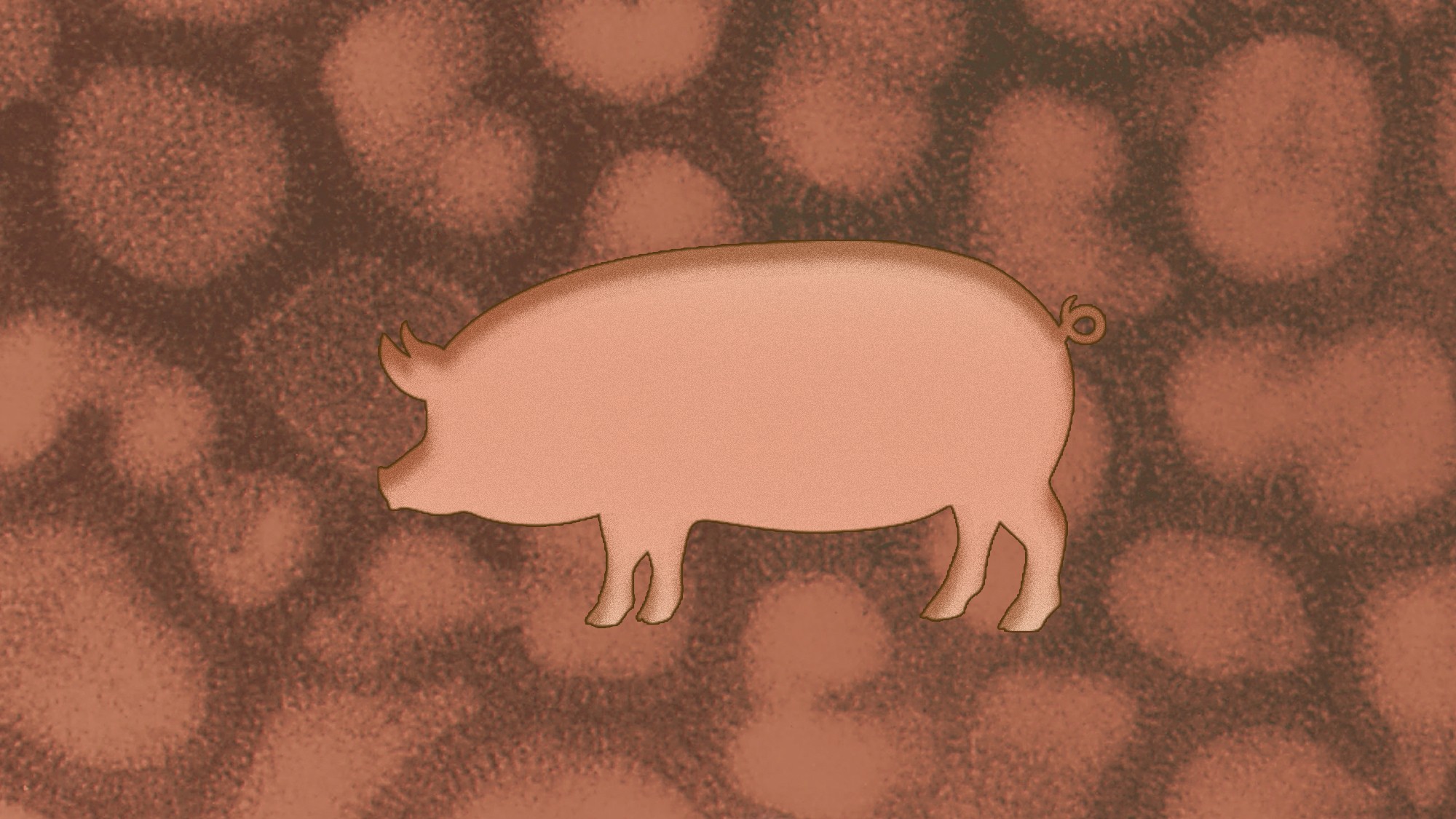Of all the creatures stricken with this new and terrible H5N1 flu—the foxes, the bears, the eagles, ducks, chickens, and many other birds—dairy cattle are some of the most intimate with us. In the United States, more than 9 million milk cows live on farms, where people muck their manure, help birth their calves, tend their sick, and milk them daily. That kind of proximity is exactly what gives a virus countless opportunities to encounter humans—and then evolve from an animals-only virus into one that troubles people too.
But as unnerving as H5N1’s current spread in cows might be, “I would be a whole lot more concerned if this was an event in pigs,” Richard Webby, the director of the World Health Organization Collaborating Centre for Studies on the Ecology of Influenza in Animals and Birds, told me. Like cows, pigs share plenty of spaces with us. They also have a nasty track record with flu: Swine airways are evolutionary playgrounds where bird-loving flu viruses can convert—and have converted—into ones that prefer to infect us. A flu virus that jumped from swine to humans, for instance, catalyzed the 2009 H1N1 pandemic. If there’s a list of riskiest animals for an avian flu to infiltrate, “pigs are clearly at the top,” Webby said.
To successfully spread in a new species, a flu virus must infiltrate that creature’s cells, reproduce inside of them, and then make it to the next host. This H5N1 has managed that feat in several animals, but so far, “we’re actually still dealing with a very avian virus,” Michelle Wille, a virologist at the University of Melbourne, told me. For the virus to spread widely in humans, scientists think that it would need to pick up several new traits; so far, they’ve detected only one such modification, which has boosted the virus’s ability to replicate inside mammalian cells.
In particular, the virus does not seem to have acquired what Webby considers the most crucial modification, one that would help it more efficiently enter human-airway cells in the first place. To do that, H5N1 would need to adjust its ability to latch on to particular sugars on cell surfaces, which effectively serve as locks to the cell’s interior. For decades, though, the virus has preferred the version of those sugars that’s most commonly found in the gastrointestinal tract of birds, and still seems to. Experts would really start to worry, Webby said, if it started glomming very tightly instead onto the ones most commonly found in human airways.
[Read: Bird flu has never done this before]
That said, the difference between those sugars is architecturally quite small. And although scientists might colloquially call some bird receptors and others human receptors, mammals can produce bird receptors, and vice versa. (Humans, for instance, have bird receptors in their eyes, which likely explains why the farm worker who appears to have caught H5N1 from a dairy cow developed only conjunctivitis.) The right animal host could encourage the virus to switch its preference from birds to humans—and pigs fit that bill. They just so happen to harbor both bird receptors and human receptors in their respiratory tract, giving the flu viruses that infect them plenty of opportunity to transform.
Just by hanging out in pigs for a while, H5N1 could enhance its ability to enter our cells. Or, perhaps even more concerning, it could encounter a flu that had already evolved to infect humans, and swaps bits of its genome with that virus. Pigs catch our viruses all the time. And should one of those pathogens hybridize with this H5N1, becoming human-adapted enough to spread among people but still avian-adapted enough to elude our immune system, a large-scale outbreak could begin. In the late 1970s, after an H1N1 avian-flu virus hopped from wild waterfowl into Europe’s pig population, it took just a few years to start infecting people in Europe and Asia. Eventually, that same virus helped birth 2009’s pandemic swine flu.
Right now flu surveillance among swine needs to be dialed up, experts told me; protections for farm workers who handle the animals should ramp up too. Seema Lakdawala, a virologist at Emory University, told me that she’d also like to see cow’s milk on farms better contained and more quickly heat-treated, so that other animals in the vicinity won’t be exposed to the liquid in its raw form. (Several farm cats, for instance, appear to have caught H5N1 by drinking raw milk on farms.)
At this point, any worry about the virus evolving dramatically in pigs is still theoretical. H5N1 hasn’t yet been detected in farm pigs, and experimental infections have found that the virus, although capable of infecting and replicating in swine, doesn’t seem to transmit easily among them. Even if that were to change, pigs may not end up being the ideal venue for the many other genetic gymnastics that would help this virus adapt to us.
That said, “we don’t fully understand all of the mutations or genetic requirements” needed to convert an avian virus, Louise Moncla, a virologist at the University of Pennsylvania, told me. Viruses sometimes surprise us: 2009’s H1N1 flu, for instance, caused a pandemic without making the genetic change that seems to have helped this new H5N1 along. Which means it’s not a complete comfort that H5N1 isn’t spreading in pigs yet—especially when so many cows are getting sick now.
[Read: America’s infectious-disease barometer is off]
Scientists know relatively little about flu in cows. Although cattle have been known to catch certain kinds of flu before, the current outbreak is the first time a type-A influenza, the group that H5N1 belongs to, has been detected in their kind. Researchers are only now starting to understand the animals’ susceptibility to these pathogens, and a recent preprint study, which Webby contributed to, revealed human-esque flu receptors in several parts of the cow body, some of which have bird receptors too—a finding that suggests that the risk posed by continued spread in cows is higher than once thought. Webby, for one, isn’t panicking yet, and he told me that the results mainly help explain why cow udders, now confirmed to be full of bird receptors, have turned out to be such great homes for H5N1. And because cows are likely spreading the virus to one another via milking equipment—basically a free ride for the pathogen—there may be little pressure for the virus to change its MO.
The bigger risk is simpler. “The things that make me the most nervous are the species that we regularly interact with all the time,” Moncla told me. The more cows catch the virus, the more exposure there will be for us, giving the virus more chances to explore and potentially adapt to our respiratory tract. Commercial milking is a messy affair: The processing machinery sprays and mists the liquid all about. Lakdawala imagines that milking an infected cow without protective equipment could be “like me squirting 10,000 or 100,000 viral particles into someone’s nose.” Just one of those particles needs to carry the right set of genetic changes for this flu to become a human one.

